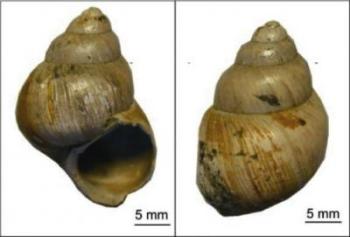Apr 23 2013
Nearly thirty-four million years ago, the Earth underwent a transformation from a warm and high-carbon dioxide "greenhouse" state to a lower-CO2, variable climate of the modern "icehouse" world. Massive ice sheets grew across the Antarctic continent, major animal groups shifted, and ocean temperatures decreased by up to 5 degrees.
 Michael Hren of the University of Connecticut and his coauthors examined these carbonate shells of the freshwater gastropod Viviparus lentus from the Hampshire Basin, United Kingdom. They used a clumped-isotope thermometer technique to determine the concentration of bonded heavy oxygen and carbon isotopes in these shells, which gives a picture of land temperatures during the Eocence-Oligocene transition, about 34 million years ago. Credit: Photo courtesy Michael Hren.
Michael Hren of the University of Connecticut and his coauthors examined these carbonate shells of the freshwater gastropod Viviparus lentus from the Hampshire Basin, United Kingdom. They used a clumped-isotope thermometer technique to determine the concentration of bonded heavy oxygen and carbon isotopes in these shells, which gives a picture of land temperatures during the Eocence-Oligocene transition, about 34 million years ago. Credit: Photo courtesy Michael Hren.
But studies of how this drastic change affected temperatures on land have had mixed results. Some show no appreciable terrestrial climate change; others find cooling of up to 8 degrees and large changes in seasonality.
Now, a group of American and British scientists have used a new chemical technique to measure the change in terrestrial temperature associated with this shift in global atmospheric CO2 concentrations.
Their results suggest a drop of as much as 10 degrees for fresh water during the warm season and 6 degrees for the atmosphere in the North Atlantic, giving further evidence that the concentration of atmospheric carbon dioxide and Earth's surface temperature are inextricably linked.
"One of the key principles of geology is that the past is the key to the present: records of past climate inform us of how the Earth system functions," says Michael Hren, Assistant Professor of Chemistry and Geosciences at the University of Connecticut and the study's lead author. "By understanding past climate transitions, we can better understand the present and predict impacts for the future."
The transition between the Late Eocene and the Oligocene epochs (between 34-33.5 million years ago) was triggered in part, the authors write in their April 22 paper in Proceedings of the National Academy of Sciences, by changes in the concentration of atmospheric CO2 that enabled ice to build up on the Antarctic continent.
Ice-sheet growth, coupled with favorable changes in the Earth's orbit, pushed the planet past a climatic tipping point and led to both the rapid buildup of a permanent ice sheet in the Antarctic and much larger changes in global climate, says Hren.
But much of what is known about this time period's climate comes from cores drilled deep in the ocean, Hren says. There, organic and inorganic remains of ancient marine creatures retain chemical signatures of ocean temperatures when they were alive.
Now, Hren and his colleagues have used a recently developed "clumped isotope thermometer" to examine terrestrial fossil shells from this time period. The team collected fossilized snails from the Isle of Wight, Great Britain, and looked for not just the kind and number of carbon and oxygen isotopes present, but how they were bound together.
The abundance of bonds containing heavy isotopes of both oxygen and carbon are temperature-dependent, so they can give a reliable picture of the terrestrial climate.
"The unique thing here is that we're using isotopologues to measure the temperature that these snails experienced, and relating that to the climate during this interval of declining CO2," Hren says.
What makes their results so important, says Hren, is that it's further evidence that CO2 is linked not only to climate by way of the vast oceans and their temperature, but by terrestrial temperatures, too.
"It gives further evidence of the close links between atmospheric CO2 and temperature, but also shows how heterogeneous this climate change may be on land," he adds.
Studies have shown that before this drastic cooling event, Earth's atmosphere contained 1000 parts per million (ppm) of CO2 or more, and by the end of the transition, it was likely lower than 600-700 ppm. Some predictions, notes Hren, suggest that Earth's current CO2 concentrations, currently at close to 400 ppm and climbing, could increase to nearly 1000 ppm in the next 100 years.
If that turns out to be the case, it's likely that temperature changes on the scale of the Eocene to Oligocene could occur – but in the other direction, toward a much warmer climate that could again fundamentally alter the living things on Earth.
"We are on a path to fundamentally alter our global climate state," says Hren. "These data definitely give you pause."